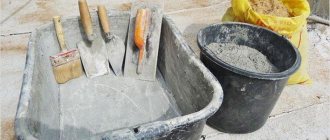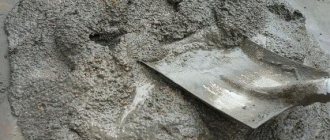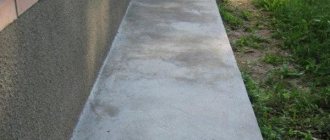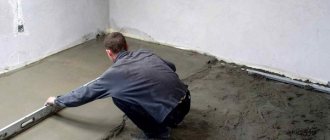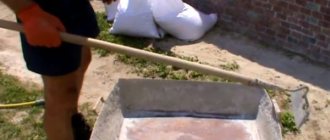The solution at home for household needs without significant requirements for the characteristics of the screed can be prepared very frivolously. The “folk” technology for preparing mortar for floor screed creates a deliberately greater safety margin than is necessary. The specific composition for the floor screed in this case is also not critical. It can include a lot of different ingredients: gravel, crushed stone, sand, ASG, expanded clay, shavings, etc. And if it is made with minimal adherence to technology and proportions, it will last for many years.
Proportions of concrete for screed in buckets
At home, it is more convenient to measure the ingredients of a concrete mixture by volume rather than by weight. A convenient measurement is a regular 10-liter bucket.
To prepare a concrete mixture of class B15 from cement grades CEM I 32.5–CEM I 42.5 (M400–M500), you will need:
- cement - 1 bucket;
- sand - 2.5–3.2 buckets;
- crushed stone - 4–5 buckets.
The volume of concrete mixture obtained from 1 bucket of cement will be 5.4–6.2 buckets.
For a concrete mixture of class B12.5 from cement grade M400–M500 you need:
- cement - 1 bucket;
- sand - 3-4 buckets;
- crushed stone - 5-6 buckets.
One bucket of cement will yield 6.5–7 buckets of concrete mixture.
How much sand do you need for 1 cubic meter of screed?
It is quite difficult to accurately calculate the consumption of sand, because unlike cement, it is stored in far from ideal conditions and already contains moisture. The numbers in the regulatory documents indicate the consumption of sand with minimal humidity, which is extremely rare in life. Experienced builders determine the viscosity of the solution by eye - the thickness of sour cream, without lumps or impurities. To calculate sand consumption, you need to know the thickness of the coating, the area of the room and the consumption per 1 m2. As a rule, the numbers vary between 20 - 25 kg of mixture per 1 m2 with a solution thickness of 1 cm.
One of the important criteria for calculations is the thickness of the screed and the area of the room.
First of all, you need to find out the volume of the solution in cubic meters. We multiply the estimated area (30 m) by the thickness (4 cm) - 30 * 0.04 = 1.2 m3 of mixture volume.
If you need to make M150 concrete from M400 cement, knowing the rate of cement consumption, we calculate - 1.2 m3 * 400 = 480 kg. The amount of sand is calculated at the rate of 1/3, i.e. for a solution of grade M150, it will be necessary - 480 * 3 = 1440 kg of sand.
Sand for private houses and apartments is purchased from river sand; for industrial premises, quarry-sown sand is chosen.
Calculation of concrete for floor screed
To calculate the concrete required for pouring a floor screed, you need to use the formula for the volume of a rectangular parallelepiped, which is taught in elementary school: multiply the length by the width and by the height, paying attention to the fact that they are all measured in the same units of measurement.
The length and width of the room are easy to measure. If the room has a complex shape, its area is found by conditionally dividing the floor into rectangular fragments and calculating their areas separately.
As for the height of the conventional parallelepiped (that is, the screed), it depends on various factors:
- the thickness of the monolithic concrete screed must be at least 20 mm and 1.5–2 times the diameter of the coarse aggregate;
- the minimum thickness of the floating screed is 40 mm;
- when installing a water heated floor, the thickness of the screed must exceed the diameter of the pipes by at least 45 mm;
- The thickness of the screed on the separating layer must be at least 35 mm.
Example:
We fill the screed in a 2x5 m room with a concrete mixture of class B15 prepared from CEM I 32.5 cement (M400); screed thickness - 50 mm.
2*5*0.05=0.5 or half a cube of concrete. 1 cube of concrete is 1000 liters or 100 buckets of concrete mixture, which means we need 50 buckets of the mixture.
Based on the above proportions, to prepare a concrete mixture you will need 10 buckets of cement, 25 buckets of sand, 40 buckets of crushed stone. As a result, you will get approximately 54 buckets of concrete mixture of the required class, taking into account the fact that about 10% of the mixture must be allocated for losses.
Having made such calculations, you can go for materials.
Requirements for the solution
It’s a completely different matter when strict requirements are imposed on the base of the floor: static and dynamic loads, wear resistance, etc. The customer can also include in the contract a footnote to the requirements of SP 29.13330.2011 (previously SNiP 2.03.13-88).
In most cases, the screed is made on the basis of cement-sand mixtures (CPS). This is the most universal method. For floors made on the basis of cement mortar, fairly high operational requirements are met at minimal production costs. How to make a mortar for floor screed based on sand and cement, observing building regulations, will be discussed here. In the case of home preparation, the above rules can be followed approximately.
Basic requirements of regulatory documentation
- To level surfaces and cover pipelines, the compressive strength of the screed must be at least 15 MPa;
- For self-leveling polymer coatings – at least 20 MPa;
- The screed layer on top of various thermal insulation is at least 20 MPa;
- The thickness of the screed is at least 1.5 times the diameter of the maximum filler;
- Peel adhesion strength after 28 days is not less than 0.6 MPa. After 7 days, at least 50% of the design value;
- The compressive strength of porous screeds is at least 5 MPa.
To obtain the grade of solution, it is enough to multiply the value by 10 (i.e. 15 MPa corresponds to grade M150).
Factors affecting screed quality
In order of importance:
- Proportions of mortar for floor screed. The exact ratio of ingredients, the sequence of their combination. Let's remember something important! Water is added after mixing the dry ingredients, the exact amount is determined by samples (depending on the humidity of the materials, air, temperature).
Various additives can be used to improve properties.
- Composition of the mixture. Cement (brand, condition), sand filler (type, preliminary preparation), various additives (plasticizers, hardeners, etc.). You can change the proportions to obtain the same grades of solution based on different components.
- Uniformity and consistency of the finished mixture. It is important to thoroughly mix the composition until a homogeneous mass is obtained. Consistency affects the uniformity and density of filling molds and the non-spreading of the mass with a decrease in cement content if the mixture is too liquid. The consistency and quantity of the prepared mixture is selected depending on the time of use.
- Time to use the finished solution. It is not recommended to use a set mortar for screeding. You can use it as a filler to level out large irregularities, holes, and dips.
- Hardening period. The screed should stand without any load for at least a day. Complete setting depends on many parameters (composition and thickness of the screed, microclimate, base on which it was laid, etc.). For calculation purposes, a period of complete setting is taken from 1 to 4 weeks. This is the period of gaining strength. Complete drying for dry work (so that the finish coat does not become damp from the screed) can take up to 2 – 3 months. If the screed is too dry and the temperature is too high, it is recommended to moisten the screed on the first day of hardening. You can also protect it from direct sunlight.
In case of extreme heat or dryness, the finished screed is moistened and covered with film for up to 7 days to prevent cracking.
Ingredients
- Cement. For the screed, cement of at least grade M200 is used (recommended M400 - M500). The strength of the screed depends on the brand. In addition to the grade, the condition of the cement is decisive. Long-term storage under unfavorable conditions degrades quality. Without testing, it is recommended to use a brand of such cement that is 2 times smaller. Petrified cement cannot be used, even in crushed form;
- Sand. For private use, any sand without a large number of foreign inclusions (branches, debris, pebbles, etc.) is suitable. If non-special construction sand is used, it will first need to be sifted through a 3-5 mm mesh. The sand should not contain a lot of clay or minerals (typical for sea sand);
Preparing sand for mortar.
- Water requirements are given in GOST 23732-2011. Can be from any uncontaminated source of water (including sea and saline). When using process water, it is recommended to check its chemical composition and suitability;
- Plasticizer. The addition of plasticizers makes the solution more plastic and prolongs the work with the prepared composition. Added in accordance with manufacturer's recommendations;
- Fiber. It is a reinforcing component of the screed.
- Lime. When introduced, the composition will be more plastic. To increase water-retaining properties;
- Clay. Increases the frost resistance of the finished solution. Used in some cases when working in the cold.
To make it at home, it is enough to use the first three components.
How to make a strong screed
In modern construction and repair work, the use of special additives has long been considered good form. The use of special additives makes it possible to make concrete of higher quality and reduce the labor intensity of work.
For screeds, it is recommended to use the universal superplasticizing and superwater-reducing additive CemPlast.
The addition of this superplasticizer (about 0.6 liters per 100 kg of cement) allows you to obtain highly mobile mixtures (increasing the mobility of the mixture from P1 to P5), which allows you to reduce the cost of concrete processing and pour a screed with a smooth surface.
Often, in order to increase the mobility of concrete mixtures, more water is added, which is a serious mistake, since excess water will not react with the cement components and will simply dry out, leaving voids in the concrete structure that reduce its strength. The addition of CemPlast allows you to obtain mobile mixtures by reducing the mixing water by 10–20%.
Cement consumption per 1 m2 of screed
Calculation of construction cement consumption for a 1m2 floor screed with a thickness of 5 cm:
- calculate the required cubic capacity of the mixture - 1m2 * 0.05 m = 0.05m2;
- cement consumption (m150) - 255 * 0.05 = 13 kg per 1m2.
When calculating all the costs for purchasing all the necessary materials, it is important to add the costs of their delivery. On the advice of experienced specialists, it is better to entrust such work to experienced craftsmen, because we are talking about the foundation on which housing or a work area will be equipped. Mistakes and savings, as a rule, in such cases lead to disastrous results and additional costs.
Polypropylene fiber
Universal polypropylene reinforcing fiber for adding to the solution.
More details
CemPlast also saves at least 10% of cement.
The addition of CemPlast prevents delamination of the mixture, extends its “life”, and also allows you to obtain stronger and 2-3 times more durable concrete and avoid the appearance of shrinkage cracks.
We advise you to study: For pouring screed and heated floors
Also, as a replacement for steel or composite reinforcement to prevent cracks and obtain a stronger screed, it is recommended to add polypropylene or basalt fiber to the concrete mixture or cement-sand mortar.
We advise you to study: To replace fittings
A durable, high-quality screed is a necessary element of indoor comfort. To fill a screed that will not crack in a couple of years, and also save energy, time, and money, use Cemmix additives, such as fiber and CemPlast superplasticizer, which can be bought in construction stores, including Leroy Merlin and wholesale from the manufacturer.
You can buy CemPlast, CemBase CEMMIX without leaving your home, with discounts from 5 to 33%!!!!
Buy on Ozon
Buy on Yandex.Market
Buy on Wildberries
Buy at Leroy Merlin
"People's" technology
Approximate ratio of cement and sand for the most common grades of cement.
Many people don’t really think about what kind of solution is needed to screed the floor. ...And the poured floor fulfills its functions. For this:
- Mix the mixture in any way (concrete mixer, drill with a mixer attachment, manually in a bath, etc.). Take approximately 1 to 3 parts of any sand (construction sand, screenings or ordinary river sand), add 1 part cement (the most common is M-400 or strength class B30). Mix dry first.
Mixing the solution.
- Then add water (about 1 - 2 parts) and stir until a homogeneous mass with the consistency of thick sour cream is obtained. Water is added according to situation. The fact is that it is only possible to accurately determine the amount of water using the sampling method. It depends on what kind of sand is used (humidity, fraction, composition), the microclimate where the work is carried out (temperature, humidity). Also, depending on the microclimate and the speed of use of the resulting solution, it is recommended to prepare the consistency - thicker or more liquid. To be more precise, the final result is influenced by the water-cement ratio in the solution, but in “folk” technology such nuances are usually neglected.
The sooner you use the solution, the better.
- Pour the resulting mixture into place and level it.
- Leave the tie to tighten. There is at least a day before moving along it, although this is often neglected and people begin to walk carefully after a few hours. Sometimes, in hot weather, the screed is additionally moistened so that the concrete hardens well.
However, such an approximate technology does not guarantee the strength of the floor, the absence of cracking, etc. With a large amount of cement, the mortar is stronger, but it dries faster and is more difficult to level, and the final quality deteriorates. By increasing the amount of sand, the setting time increases, but the final strength decreases. Thus, by varying “by eye” you can make a significant mistake. It is better to follow the recommendations given by experts. But this is a “folk” technology without special requirements.
Cost of work
Independent preparation of high-quality cement-sand composition is an operation that requires compliance with proportions and involves the use of proven raw materials. Not always novice developers who have not had to carry out construction work can correctly prepare a working mixture with the specified performance properties. The help of experienced builders will help prevent mistakes and avoid unexpected financial expenses. What is the price of professional services?
The approximate level of costs for preparing the cement composition and pouring it is determined by the following factors:
- dimensions of the poured base;
- brand of building materials used;
- type of pre-coating.
The cost is also affected by the amount of additional work associated with the removal of coatings that have become unusable and the dismantling of utilities.
Depending on these factors, the price level for cement work ranges from 300 to 700 rubles per square meter of area. The maximum price corresponds to turnkey work using our own materials and equipment, which are delivered to the site by the transport organization of the performing organization.
Preparing the mixture
If the mixture was purchased ready-made, then there are usually no problems with it. All you need to do is follow the manufacturer’s recommendations, which are on the packaging or in the instructions for use. You just need to thoroughly knead the entire mixture with a construction mixer until it reaches a homogeneous consistency, reminiscent of sour cream.
If you wish, you can not take the ready-made mixture, but make it yourself. For example, to obtain M300 you need to take part of the M400 cement mixture and mix it with two parts of sifted clean sand.
Preparing the mixture is a simple matter
What is cement?
Cement is an indispensable component in the construction field; the construction of any structure cannot be done without it. The components from which cement is produced are quite simple - these are ordinary clay and limestone, but in order to obtain cement, these components need to be mixed, subjected to heat treatment to form clinker, and the clinker is then ground to a fine powder.
The gray fine powder obtained after grinding clinker is cement; if you mix it with water, you get stone; the peculiarity of cement is the ability to harden in air and resist moisture, while the cement stone only becomes stronger .
What is Portland cement?
Portland cement consists largely of calcium silicate - belite and alite in its composition, it reaches almost 80% of the total composition, this type of cement is most popular all over the world, and it received its name thanks to the island located in the UK because the rocks located on it have identical color.
The composition of Portland cement includes clinker, gypsum, and mineral additives can also be included to improve characteristics - this composition of components provides the cement with a rapid hardening process in air and water.
After the process of firing the components is completed, the clinker is allowed to cool and then thoroughly crushed, turning into dust, so that the sulfur oxide in the finished product is within the normal range of 1.5 to 3.5%, gypsum is added to the cement.
How to reduce dry cracks
Cement screed with quartz filler is prone to cracking. This moment reduces the strength of the coating, load-bearing capacity and durability. To eliminate this phenomenon, you can add polypropylene fiber to the solution. In everyday life, the “old-fashioned method” allows the use of alternatives: metal shavings, small nails, wire scraps. All this acts as a reinforcing filler.
This action is taken when a cement screed is poured onto a rigid base in a thick layer. Reinforcement is important if a high and constant load on the floors is planned. This increases the compressive and tensile strength of the dry residue and strengthens the bond of components in the solution. In addition, if the coating is used independently, wear resistance due to additives is noticeably increased.
There is a technology according to which a minimum amount of water is added to the composition. This is the “semi-dry screed” method.
We will apply the method when it is only important to activate the binder, reduce the load on the base and speed up the hardening process of the mass. But here the risk of cracks is higher than with the classic version. The addition of reinforcing fibers in this case is mandatory.
Types of floor screeds
There are a number of types of floor screeds.
Let's briefly describe them:
- concrete is the most common option for such a coating. It is based on cement grade M-400 or M-500. Sand and crushed stone are mixed with it. It should be noted that the grade of concrete used in this case for floor screed is M-150 or M-200. The resulting surface is gray or a shade thereof;
Concrete surface
- anhydride - in it anhydride acts as the main component. This is the name of the composition obtained by burning natural gypsum. This screed forms a durable and smooth cream-colored surface;
Anhydride coating
- mosaic (terratio) - this is the name of the screed performed on top of a cement or concrete surface. The main components of this composition are Portland cement, stone chips, and coloring pigments. Its use allows you to create a surface with an unusual pattern;
Mosaic surface
- foam concrete – has good heat and sound insulation properties. Floor screed with foam concrete can be created on various types of base without preliminary preparation. The resulting coating is gray in color;
Foam concrete surface
- magnesite (xylolite) - includes magnesite (xylolite) cement, dye, sand, water and sawdust mixture. Forms a smooth grayish coating, on top of which wood particles are visible;
In the photo - magnesite coating
- cast asphalt can also act as a screed. It consists of bitumen, sand and small crushed stone. This mixture is heated to a temperature of 250 degrees, after which it is laid and compacted with a hand roller. The hand-made coating has a rough surface and a dark color;
Asphalt variety
- screed treated with synthetic resins - it is created by laying a self-leveling floor on a previously created concrete screed. The main components in the applied mixture are epoxy and polyurethane resins. The result is a very smooth surface that can be of almost any color.
Synthetic coating
Filling the screed
Filling the screed
Before starting work, you need to clear the pouring area of debris and the like. Then:
- we lay waterproofing or treat the surface with a primer;
- We set up beacons. Step no more than 60 cm;
- pour the solution. We level it so that the level of the screed coincides with the level of the beacons;
- After pouring, leave the screed to dry. After a day you can already work on it, although it will gain full strength within two weeks, depending on the temperature. The higher the room temperature, the faster the solution sets;
- if you need to level the surface of the screed, fill in another layer. Just remember that each subsequent layer must be of the same strength as the previous one.
Self-leveling floor pouring technology
The prepared mixture is gradually poured onto the concrete base, starting from the recesses (if any). The mixture is then spread with a notched trowel and leveled with a notched roller.
Leveling the mixture with a toothed roller
After pouring, the coating must be compacted, removing air from it. For this procedure, special shoes are used - “crampons”. You can use the new floor only after it has completely dried (the time is determined according to the instructions).
Common Mistakes
- The self-leveling floor is called self-leveling because the plastic mixture spreads, forming a perfectly flat surface. But sometimes the mixture needs help. When the spilled solution does not reach the corner, it is stretched there using a notched trowel.
- An incorrectly selected roller may move the mixture too intensively, or not move it at all. The needles of the “correct” roller should be 1-2 mm higher than the filling level.
- It is better to provide dampers in advance and take into account the height of the threshold, even if it seems that the threshold is high enough and is capable of containing the spilled mixture in the room. However, the slope of a room can be deceptive. In any case, the installed dampers will not interfere, but they will eliminate the need to urgently look for suitable materials to create a barrier in the path of the flowing mixture.
- Don’t save time and make a preliminary measurement of the heights of the room. There are cases when some irregularities are not visible to the eye before pouring the mixture. And after the work is completed, a protruding bump will ruin the entire repair and require additional expenses.
Despite some features and nuances, screeding a floor with a self-leveling ready-made mixture is a fairly simple and very interesting process that does not require professional skills and provides an excellent result.
Filling a self-leveling floor: preparation of the solution and pouring technology Self-leveling floor screed: mixture composition and pouring technology Self-leveling floor: necessary materials and pouring technology How to make a concrete floor in a garage: requirements and pouring technology
The importance of proportions
Currently, the range of floor coverings is teeming with variety: putty, tiles, plaster, etc. However, it is impossible to know about their strength and the volume of added cement by purchasing them ready-made. In addition, there are various chemical additives that increase the strength of materials. And in this again the main role is given to cement. You should know that during the manufacturing process the same amount of cement is added at the factory; they do not skimp on this, and the indicated strength, as a rule, corresponds to the actual one.
The range of dry building mixtures for screed is huge and is in demand on the market.
DSP grades by strength
Marking of cement-sand mortars according to the compressive strength of the hardened mortar is carried out with the capital letter M and the numbers 4, 10, 50, 75, 100, 150, 200.
For example, DSP screed M150 means that cement-sand mortar grade 150 with the following characteristics was used for it:
Please note that M150 concrete must have a standard strength class of B12.5. The table contains data for mortars, not concrete.
Cement mortars M4–M200 have characteristics similar, but different from these.
Please note that there is a big difference between the underlying layer and the screed layer. The covering layer is made of concrete, and the screed is made of various mortars, one of which is cement-sand mortar.
Let me remind you that the minimum thickness of a cement-sand mortar screed on a concrete underlying layer or floor slab is 20 mm. In multi-layer floor construction, the minimum thickness of the screed should be increased to 40 mm. For example, on a sound insulation layer.
If we look at the working drawing albums of the 2.144-1/88 series recommended in the standards, we will see that M150 mortar is recommended for all floor structures where a cement-sand mixture screed is used.
Mortars M100 and M200 according to regulatory documents are NOT used for screeds made of cement-sand mortar. Although in practice, due to similar parameters, solutions M100 and M200 are used for concrete screeds.
What points are important when buying cement for screed?
For home construction, it is recommended to purchase packaged material, since bulk material is more difficult to determine the date of manufacture, and moreover, it is more difficult to store. It is usually sold in durable paper bags of 25 and 50 kg. The packaging indicates the brand of binder according to the old and new GOSTs, batch number, production date, recommendations for storage and use. When purchasing cement for screed, you should inspect the packaging for integrity and feel the bag (the contents should be soft to the touch, without lumps). The release date should be as late as possible. Even with proper storage, cement loses approximately 15% of its original performance characteristics every three months. If you have to use cement that has been stored properly for a long time, its percentage in the mortar or mixture must be increased by 15-20%.
